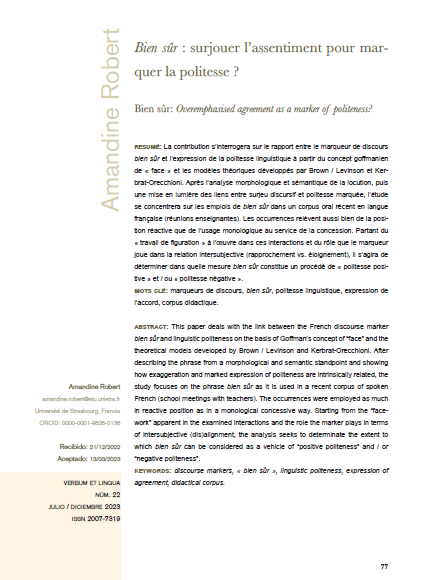Bien sûr: Overemphasised agreement as a marker of politeness?
DOI:
https://doi.org/10.32870/vel.vi22.211Keywords:
discourse markers, « bien sûr », linguistic politeness, expression of agreement, didactical corpusAbstract
This paper deals with the link between the French discourse marker bien sûr and linguistic politeness on the basis of Goffman’s concept of “face” and the theoretical models developed by Brown / Levinson and Kerbrat-Orecchioni. After describing the phrase from a morphological and semantic standpoint and showing how exaggeration and marked expression of politeness are intrinsically related, the study focuses on the phrase bien sûr as it is used in a recent corpus of spoken French (school meetings with teachers). The occurrences were employed as much in reactive position as in a monological concessive way. Starting from the “face-work” apparent in the examined interactions and the role the marker plays in terms of intersubjective (dis)alignment, the analysis seeks to determinate the extent to which bien sûr can be considered as a vehicle of “positive politeness” and / or “negative politeness”.
Downloads
Metrics
References
Anscombre, Jean-Claude (2001). À coup sûr, bien sûr. Des différentes manières d’être sûr de quelque chose. In H. Dupuy-Engelhardt, S. Palma & J. E. Tyvaert (Eds), Les phrases dans les textes. Les sons et les mots pour les dire. Les connecteurs du discours. L’opposition verbo-nominale en acte (pp 135-160). Reims : Presses Universitaires de Reims.
Bertrand, Yves (2017). Langue et politesse. Nouveaux Cahiers d’Allemand, 3 : 305-313.
Brown, Penelope / Levinson, Stephen (1978). Universals in Language Usage: Politeness Phenomena. In E. Goody (Ed.), Questions and Politeness: Strategies in Social Interaction (pp. 56-310). Cambridge: Cambridge University Press.
Charaudeau, Patrick / Maingueneau, Dominique (dir.) (2002). Dictionnaire d’analyse du discours. Paris : Editions du Seuil.
Goffman, Erving [1974] (1993). Les rites d’interaction. Paris : Minuit.
Haverkate, Henk (1994). La cortesía verbal. Madrid : Gredos.
ICOR (2013). Convention ICOR. UMR 5191 ICAR (CNRS – Lyon 2 – ENS de Lyon). http://icar.univ-lyon2.fr/projets/corinte/documents/2013_Conv_ICOR_250313.pdf
Kerbrat-Orecchioni, Catherine (1996). La Conversation. Paris : Seuil.
Lambert, Frédéric / Col, Gilles (2020). Les fonctions discursives de voilà : retour sur les valeurs aspectuelles et déictiques de voilà en emploi absolu. In G. Col, C. Danino et S. Bikialo, Polysémie, usages et fonctions de « voilà » (pp. 123-151). Beihefte zur Zeitschrift für romanische Philologie, Volume: 427. De Gruyter.
Lefeuvre, Florence (2021). Analyse outillée du marqueur discursif bien sûr. L’information grammaticale. halshs-03355115
Rabatel, Alain (2012). Ironie et sur-énonciation. Vox Romanica, 71 : 42-76.
Rey, Alain (2000). Dictionnaire historique de la langue française. Paris : Dictionnaire Le Robert.
Robert, Amandine (2021). Corpus oral personnel. Exemples de la contribution consultables à l'adresse https://seafile.unistra.fr/d/058299f6008b4dc0b2fb/
Schneider-Mizony, Odile (2018). L’argumentation véridictionnelle. Nouveaux Cahiers d’Allemand, 2 : 149-163.

Additional Files
Published
Versions
- 2024-08-30 (2)
- 2023-07-01 (1)












